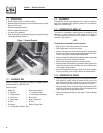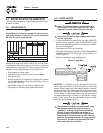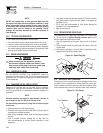
12
2.9 AUTOMATIC IDLE CONTROL
This feature is designed to greatly improve fuel economy. When
this switch is turned “On,” the engine will only run at its normal fast
governed engine speed when electrical load is connected. When
the load is removed, the engine will run at a reduced speed of 2100
RPM. With the switch “Off,” the engine runs at the normal fast engine
speed all the time. Always have the switch OFF when starting and
stopping the engine.
2.10 COLD WEATHER OPERATION/ DE-ICER
Under certain weather conditions (temperatures below 40° F (4°
C) and a high dew point), the engine may experience icing of the
carburetor and/or the crankcase breather system. To eliminate this
problem, this generator engine is fitted with a winter/summer valve.
This directs hot air into the carburetor during cold weather operation.
Always make sure the winter/summer valve is in the correct location
relative to the weather conditions.
2.11 LOW OIL PRESSURE SHUTDOWN
SYSTEM
The engine is equipped with a low oil pressure sensor that shuts down
the engine automatically when the oil pressure drops below 10 psi. If
the engine shuts down by itself and the fuel tank has enough gasoline,
check engine oil level.
2.11.1 INITIAL START-UP
A delay built into the low oil shutdown system allows oil pressure to
build during starting. The delay allows the engine to run for about 10
seconds before sensing oil pressure.
2.11.2 SENSING LOW OIL PRESSURE
If the system senses low oil pressure during operation, the engine
shuts down.
2.11.3 RESTARTING
If trying to restart the engine within 10 seconds after it shuts down,
the engine may NOT start. The system needs five (5) to 10 seconds
to reset.
If the engine is restarted after such a shutdown and the low oil
pressure has not been corrected, the engine will run for about 10
seconds as described above and then stop.
2.12 CHARGING A BATTERY
DANGER
Storage batteries give off explosive hydrogen
gas while recharging. An explosive mixture will
remain around the battery for a long time after
it has been charged. The slightest spark can
ignite the hydrogen and cause an explosion.
Such an explosion can shatter the battery and
cause blindness or other serious injury.
DANGER
Do not permit smoking, open flame, sparks
or any other source of heat around a battery.
Wear protective goggles, rubber apron and
rubber gloves when working around a battery.
Battery electrolyte fluid is an extremely caustic
sulfuric acid solution that can cause severe
burns. If spill occurs flush area with clear water
immediately.
This generator has the capability of recharging a discharged 12 Volt
automotive or utility style storage battery. Do not use the unit to
charge any 6 Volt batteries. Do not use the unit to crank an engine
having a discharged battery.
This battery charger is a pulse type designed to provide a quality
charge current into the battery. The voltage measured at the outlet
should be 8-12 VDC. This is normal and does not indicate a faulty
charging system.
To recharge 12 Volt batteries, proceed as follows:
Check fluid level in all battery cells. If necessary, add ONLY distilled
water to cover separators in battery cells. Do not use tap water.
If the battery is equipped with vent caps, make sure they are
installed and are tight.
If necessary, clean battery terminals.
Connect battery charge cable connector plug to panel receptacle
identified by the words "12-VOLT D.C."
Connect battery charge cable clamp with red handle to the positive
(+) battery terminal.
Connect battery charge cable clamp with black handle to the
negative (-) battery terminal.
Start engine. Let the engine run while battery recharges. Engine
idle control switch must be in off position for battery charging.
When battery has charged, shut down engine.
NOTE:
Use an automotive hydrometer to test battery state of charge and
condition. Follow the hydrometer manufacturer's instructions
carefully. Generally, a battery is considered to be at 100% state
of charge when specific gravity of its fluid (as measured by
hydrometer) is 1.260 or higher.
•
•
•
•
•
•
•
•
Section 2 – Operation


















